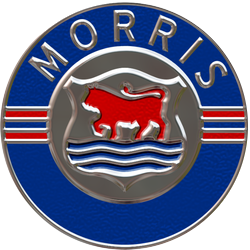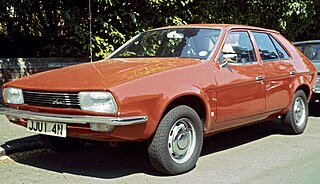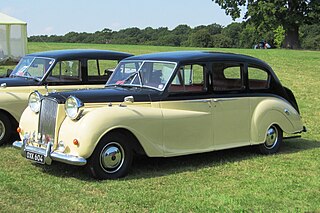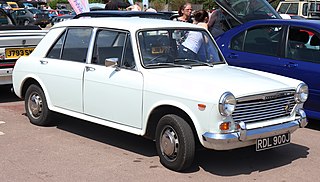
Land Rover is a British brand of predominantly four-wheel drive, off-road capable vehicles, owned by multinational car manufacturer Jaguar Land Rover (JLR), since 2008 a subsidiary of India's Tata Motors. JLR currently builds Land Rovers in Brazil, China, India, Slovakia, and the United Kingdom. The Land Rover name was created in 1948 by the Rover Company for a utilitarian 4WD off-roader; yet today Land Rover vehicles comprise solely upmarket and luxury sport utility cars.

The Mini is a small, two-door, four-seat car, developed as ADO15, and produced by the British Motor Corporation (BMC) and its successors, from 1959 through 2000. Minus a brief hiatus, original Minis were built for four decades and sold during six, from the last year of the 1950s into the last year of the 20th century, over a single generation, as fastbacks, estates, and convertibles.

Morris Motors Limited was a British privately owned motor vehicle manufacturing company formed in 1919 to take over the assets of William Morris's WRM Motors Limited and continue production of the same vehicles. By 1926 its production represented 42 per cent of British car manufacture—a remarkable expansion rate attributed to William Morris's practice of buying in major as well as minor components and assembling them in his own factory. Self-financing through his enormous profits Morris did borrow some money from the public in 1926 and later shared some of Morris Motors' ownership with the public in 1936 when the new capital was used by Morris Motors to buy many of his other privately held businesses.

The Morris Marina is a front-engined, rear-wheel-drive small family car that was manufactured by the Austin-Morris division of British Leyland from 1971 until 1980. It served to replace the Morris Minor in the Morris product line, which had first been built in 1948. The Marina was also sold in some markets as the Austin Marina, the Leyland Marina and the Morris 1700.

The Austin Motor Company Limited was an English manufacturer of motor vehicles, founded in 1905 by Herbert Austin in Longbridge. In 1952 it was merged with Morris Motors Limited in the new holding company British Motor Corporation (BMC) Limited, keeping its separate identity. The marque Austin was used until 1987. The trademark is currently owned by the Chinese firm SAIC Motor, after being transferred from bankrupt subsidiary Nanjing Automotive which had acquired it with MG Rover Group in July 2005.

The Princess is a large family car produced in the United Kingdom by the Austin-Morris division of British Leyland from 1975 until 1981. The car inherited a front-wheel drive / transverse engine configuration from its predecessor, the Austin/Morris 1800 range. This was still unusual in Europe for family cars of this type and gave the Princess a cabin space advantage when compared with similarly sized cars from competing manufacturers.

The Austin Princess is a series of large luxury cars that were made by Austin and its subsidiary Vanden Plas from 1947 to 1968. The cars were also marketed under the Princess and Vanden Plas marque names.

The Land Rover Defender is a series of British off-road cars and pickup trucks. They consistently have four-wheel drive, and were developed in the 1980s from the original Land Rover series which was launched at the Amsterdam Motor Show in April 1948. Following the 1989 introduction of the Land Rover Discovery, the term 'Land Rover' became the name of a broader marque, and thus no longer worked as the name of a specific model; thus in 1990 Land Rover renamed the 90 and 110 as Defender 90 and Defender 110 respectively. The 127 became the Defender 130.

The Triumph 1300 is a medium/small 4-door saloon car that was made between 1965 and 1970 by Standard Triumph in Coventry, England, under the control of Leyland Motors. It was introduced at the London Motor Show in October 1965 and intended as a replacement for the popular Triumph Herald. Its body was designed by Michelotti in a style similar to the larger Triumph 2000. It was replaced by the Triumph 1500, though it was also re-engineered in the early 1970s to provide the basis for the Toledo and Dolomite ranges.

The Mini Moke is a small, front-wheel-drive utility and recreational convertible, conceived and manufactured as a lightweight military vehicle by British Motor Corporation (BMC), and subsequently marketed for civilian use under the Austin, Morris, Leyland, and Moke brands. The name "Mini Moke" combines Mini with Moke, an archaic term for "mule". The Moke is known for its simple, straightforward, doorless design, and for its adaptability.

The BMC ADO16 is a range of small family cars built by the British Motor Corporation (BMC) and, later, British Leyland. Launched in 1962, it was Britain's best-selling car from 1963 to 1966 and from 1968 to 1971. The ADO16 was marketed under various make and model names; however, the Austin 1100 and Morris 1100 were the most prolific of all the ADO16 variants. The car's ubiquity at the height of its popularity led to it simply being known as the 1100 (eleven-hundred) in its home market.

The MGB is a two-door sports car manufactured and marketed from 1962 until 1980 by the British Motor Corporation (BMC), later the Austin-Morris division of British Leyland, as a four-cylinder, soft-top sports car. It was announced and its details first published on 19 September 1962. Variants include the MGB GT three-door 2+2 coupé (1965–1980), the six-cylinder sports car and coupé MGC (1967–69), and the eight-cylinder 2+2 coupé, the MGB GT V8 (1973–76).

The Austin Champ was a military and civilian jeep-like vehicle made by the Austin Motor Company in the 1950s. The army version was officially known as "Truck, 1/4 ton, CT, 4×4, Cargo & FFW, Austin Mk.1" however the civilian name "Champ" was universally, if unofficially, applied to it. The majority of Champs produced went to the British Army.

The LDV Pilot is a panel van that was produced by LDV Limited from 1996 until 2005, and closely based on preceding models dating back to the 1974 Leyland Sherpa.

The Range Rover Classic is a 4x4, mid-size Sport utility vehicle series produced from 1969 to 1996 – initially by the Rover division of British Leyland, and latterly by the Rover Group.

The Morris Commercial J4 was a 10 cwt forward-control van launched by Morris Commercial in 1960 and produced with two facelifts until 1974.

The Land Rover series I, II, and III are compact British off-road vehicles, produced by the Rover Company since 1948, and later by British Leyland. Though inspired by the World War II jeep, the Land Rover immediately distinguished itself from all other cars. From launch, it was the first mass-produced civilian four-wheel drive car with doors on it, and an available hard roof. Contrary to conventional car and truck chassis, it used a sturdier fully box-welded frame. Furthermore, due to post-war steel shortage, and aluminium surplus, Land Rovers received non-rusting aluminium alloy bodies, favouring their longevity. In 1992, Land Rover claimed that 70% of all the vehicles they had built were still in use.
British Motor Corporation (Australia) was a motor manufacturing company formed in Australia in 1954 by the merger of the Austin Motor Company (Australia) and Nuffield (Australia). This followed the merger in 1952 of the Austin Motor Company and the Nuffield Group in the United Kingdom to form the British Motor Corporation. Following further corporate changes in the UK in the late 1960s, BMC Australia was absorbed into the newly established British Leyland Motor Corporation of Australia, the name of which became Leyland Motor Corporation of Australia in 1972, and then JRA Limited in March 1983.

Fitted For Wireless (FFW) and Fitted For Radio (FFR) were British Army designators for vehicles equipped to carry radio equipment. Although many of these vehicles were dedicated 'radio vans' and had complex and expensive radio sets installed, the intention was also that general purpose vehicles could be issued in 'FFW' state with the low-cost but time-consuming cabling and equipment mounts already prepared. The actual sets themselves could be installed later, if a new radio vehicle was required owing to damage or breakdown.
There have been a number of Mini concept cars, produced to show future ideas and forthcoming models at international motorshows.


















